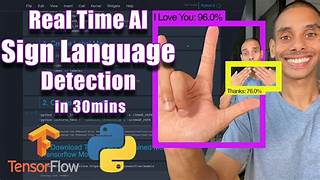Developing AI Systems for Real-Time Language Interpretation for the Deaf and Hard of Hearing
Introduction
Artificial Intelligence (AI) is revolutionizing numerous aspects of human life, and one of the most impactful applications is in assisting individuals with disabilities. Among these advancements, AI-driven real-time language interpretation tools are transforming communication for the deaf and hard of hearing. These systems use machine learning, natural language processing (NLP), and computer vision to provide instant translation of spoken language into sign language, text, or other accessible formats.
The Need for AI in Language Interpretation
Millions of people worldwide experience hearing impairments, which often create barriers to effective communication in various settings, including education, workplaces, healthcare, and public services. Traditional solutions such as sign language interpreters and captioning services have limitations in terms of availability, cost, and accessibility. AI-based systems offer an alternative by providing real-time assistance without the need for human interpreters, allowing deaf and hard-of-hearing individuals to communicate more freely and independently.
How AI-Powered Interpretation Works
AI-based real-time language interpretation for the deaf and hard of hearing relies on several key technologies:
- Speech Recognition: AI-powered speech-to-text conversion enables real-time captioning of spoken language. Advanced models such as Google’s Speech-to-Text API or OpenAI’s Whisper have significantly improved accuracy, making live transcription more reliable.
- Natural Language Processing (NLP): NLP helps AI systems understand context, detect nuances in speech, and improve the accuracy of text translations, ensuring that the meaning remains intact in conversations.
- Computer Vision: AI-driven sign language recognition involves using cameras to analyze hand gestures, facial expressions, and body language. This technology enables bidirectional communication between deaf users and those who do not know sign language.
- Gesture Recognition and Deep Learning: Machine learning algorithms trained on large datasets of sign language gestures can recognize and translate signs into text or spoken language in real time.
- Augmented Reality (AR) and Virtual Avatars: Some AI systems use AR or virtual sign language interpreters to provide a visual representation of speech in sign language, making communication more interactive and effective.
Applications of AI in Language Interpretation
The development of AI-driven interpretation tools has led to significant improvements in various sectors:
1. Education
AI-driven captioning and sign language interpretation allow deaf and hard-of-hearing students to access educational materials more effectively. Automated lecture transcriptions, real-time sign language translation, and AI tutors can help bridge the communication gap in classrooms.
2. Workplace Integration
AI systems facilitate smooth communication in professional environments, allowing deaf employees to participate in meetings, presentations, and discussions without the need for human interpreters. Automated transcription services and AI-powered video conferencing tools provide inclusive solutions for diverse workforces.
3. Healthcare Access
In healthcare settings, accurate communication between doctors and patients is critical. AI-driven language interpretation tools help deaf individuals communicate with medical professionals, improving diagnosis, treatment, and overall patient experience.
4. Public Services and Social Inclusion
Government services, emergency response teams, and public facilities can integrate AI interpretation tools to provide accessible communication for the deaf community. This enhances inclusivity in everyday interactions, from visiting banks to accessing legal services.
Challenges and Limitations
Despite its potential, AI-driven real-time language interpretation faces several challenges:
- Accuracy and Context Understanding: AI models must be trained on diverse datasets to ensure they accurately interpret spoken language and sign language across different dialects and cultural contexts.
- Privacy Concerns: Using AI for real-time interpretation often requires recording and processing audio or video, raising privacy and security concerns.
- Technical Constraints: Real-time processing requires robust computing power and stable internet connectivity, which may not always be available.
- User Adaptation and Acceptance: Some deaf individuals may prefer traditional communication methods and be reluctant to rely on AI solutions.
The Future of AI in Language Interpretation
As AI technology advances, future developments will likely focus on improving the accuracy and efficiency of interpretation systems. Emerging trends include:
- AI-enhanced wearable devices such as smart glasses that provide real-time captions or sign language translation.
- Improved sign language datasets to enhance the ability of AI systems to recognize and interpret different sign languages.
- Integration with IoT and smart home devices to assist deaf individuals in various aspects of daily life.
- Greater personalization through AI-driven adaptive learning, which allows systems to tailor interpretations based on user preferences and needs.
Conclusion
AI-powered real-time language interpretation is transforming the way deaf and hard-of-hearing individuals communicate and interact with the world. By leveraging speech recognition, NLP, computer vision, and deep learning, these technologies provide greater accessibility and inclusivity in education, workplaces, healthcare, and public services. Although challenges remain, ongoing advancements in AI will continue to enhance these systems, ensuring a future where communication barriers for the deaf community are significantly reduced.


